doug elkins choreography, etc. performs a new work and an old one at Jacob’s Pillow.
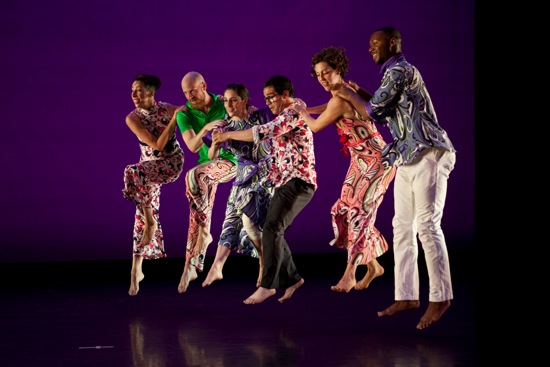
Doug Elkins’s Hapless Bizarre. (L to R): Deborah Lohse, Aaron Mattocks, Cori Marquis, Mark Gindick, Donnell Oakley, Kyle Marshall. Photo: Jamie Kraus
So what if you’re a nerd, and the woman you crave is a lot taller than you? Watch her and her bunch of friends; maybe you can pick up a few things that will make them accept you. Perhaps playing the clown will work?
Mark Gindick really is a clown (as well as an actor and a dancer), and the clique that he aims to join in Doug Elkins’s new Hapless Bizarre is a pretty sassy one. Costume designer Oana Botez has garbed the in-crowd (Deborah Lohse, Cori Marquis, Kyle Marshall, Aaron Mattocks, and Donna Oakley—all terrific) in candy-colored paisley, and early in the dance, three pairs of hands reach around Grindick from behind, help unbutton and remove his blah white shirt, and re-fit him in one that matches what Lohse is wearing.
When Hapless Bizarre begins, Gindick’s own bowler hat is mysteriously evading him, but before long the others are passing it slyly around, taking slippery turns donning it or slipping it onto various other heads, while he makes futile grabs for it. The performers handle this so adroitly that I’m reminded of the opening passage of Twyla Tharp’s 1976 Push Come to Shove, in which Mikhail Baryshnikov and his colleagues in American Ballet Theatre executed expert sleight-of hand with a hat. In Elkins’s piece, which played in Jacob’s Pillow’s Doris Duke Studio Theater this past week, a pink hat is eventually substituted for the drab one.
Pop hits, such as “Hello My Love” and “I’m Your Puppet on a String,” stud original music by Justin Levine and Matt Stine. Occasionally the static-surrounded male voice of an announcer eggs our hero on with advice, such as “How do you choose a date?” This is a party or a club where couples dance—maybe even waltz—in inventive ways, grooving with the music. Lighting designer Amanda K. Ringger supplies color-charged backgrounds, including one with a gold moiré pattern that ripples.
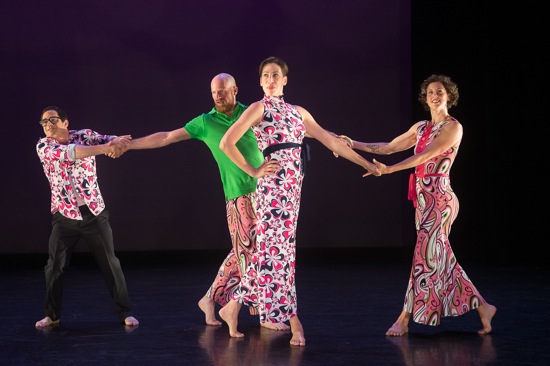
(L to R): Mark Gindick, Aaron Mattocks, Deborah Lohse, and Donnell Oakley in Elkins’s Hapless Bizarre. Photo: Christopher Duggan
Elkins could be channeling Tharp (or not). Vaudeville, hip-hop, modern dance, social dance, and circus pop up within Hapless Bizarre”s finely woven texture too. He is a witty, resourceful, and highly musical choreographer. In Gindick’s duet with Lohse (playing the suave sophisticate with her usual delicious comedic flair) it’s hard to tell who’s the puppet and who’s pulling the strings. Gindick’s legs lock around Lohse, but he’s her pillow when she needs a rest. A kiss is followed by a well-timed slap. There’s a lot of intrepid dancing in the piece. Marshall and Mattocks launch themselves into a duet. In one terrific quartet, Gindick, Lohse, Oakley, and Mattocks hold hands and work themselves through an array of crazy slipknots without ever letting go, even when a potential snarl looms. In the end, the pink hat falls from above. Lohse picks it up and nicely offers it to Gindrick. Pause. He tosses it away; she’s what he wants.
Elkins often gets you laughing, certainly smiling, then turns the tables and, without a trace of sentimentality, moves you almost to tears.
That is certainly true of his Mo(or)town/Redux, a 2012 remake of his marvelous 1990 piece of the same name. The program acknowledges his sources—not just Shakespeare’s Othello but José Limón’s masterful condensed version of it, The Moor’s Pavane. From Limón, Elkins borrowed the idea of a shifting quartet in which the tale of jealous love, treachery, and death would be played out. Like Limón, he makes the love gift of a handkerchief that Othello bestows on Desdemona a crucial prop. Limón, however, set his courtly quartet to music by Henry Purcell, and Elkins, as his title indicates, has delved into Motown and chosen songs that are remarkable apt.
Watching Mo(or)town/Redux, you feel as if you watching Othello from a carefully narrowed perspective. There is no Cassio on whom Iago can plant the accidentally dropped handkerchief to “prove” Desdemona’s infidelity (thus revenging himself on his General, Othello, for promoting Cassio over him). There are no foreign wars, family machinations, or affairs of state. Just Othello, Desdemona, Iago, and his wife Emilia, Desdemona’s maidservant.
The work opens with a spooky allusion to Motown and to Othello’s status. Marshall, wearing a white jacket, stands majestically beside a microphone, eyeing the audience, and tipping the mic stand as if it were a ceremonial staff or a potential weapon. Then he drapes his jacket over it and dances with Oakley’s Desdemona, whose simple white dress (by Naoko Nagata) proclaims her innocence. This is the kind of sweetly amorous duet when a thank-you kiss for the gift of a handkerchief is succeeded by the lovers tenderly helping each other into cartwheels. You might think this inappropriate, but take my word for it, it’s not.
When Iago (Alexander Dones) enters with Emilia (Marquis), the four dance as two pairs and also as a interdependent ensemble, coming together, circling. Without breaking the flow of the dancing, Elkins ratchets up the impending drama. Yes, Oakley accidentally drops the talismanic handkerchief. Yes, Marquis dances with it, as if playing at being the lady she serves. Dones has a virtuosic solo that wonderfully expresses his self-esteem and his evil planning. He congratulates himself with pirouettes and a stray cabriole, and the way his legs enwrap each other when he drops into breaking-based stunts suggests his deviousness.
Heather Smaha’s lighting convey the changing tides of passion—now the backdrop turns blue, now blood red. Occasionally the performers act in something close to slow motion. And the music acts as a haunting clue to their characters’ emotions. As Dones enters to take the handkerchief from his dutiful wife (who doesn’t know why he wants it), we are hearing “Will You Still Love Me Tomorrow?” And when Marshall dances Othello’s tormented solo, Marvin Gaye is singing a cappella “I Heard It on the Grapevine” (“Ooh, I bet you’re wondering’ how I knew/’Bout your plans to make me blue/With some other guy you knew before. . .”).
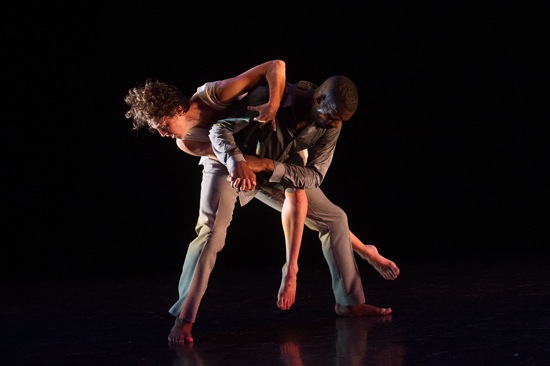
The last duet: Donnell Oakley (Desdemona) and Kyle Marshall (Othello) in Elkins’s Mo(or)town/Redux. Photo: Christopher Duggan
The final duet is both hair-raising and heartbreaking. Oakley eloquently shows Desdemona’s puzzlement and her growing wariness. Marshall kisses her neck, and when he walks away, she runs at him and leaps onto him. The Moor’s strangling of his wife is presented without grisly detail, but we feel it in our bones, and Marshall shows both his fury and grief with a simple eloquence that never descends into ranting.
Elkins has brilliantly captured the rhythms of this tragedy in the dancing he has devised, in the pauses, in the looks. And one need not be familiar with Shakespeare’s play to be moved by Mo(or)town/Redux. The tale also acquires a resonance from its music and memories of the racial issues of the 1960s: leaders betrayed, battles fought, lessons learned, examples set.

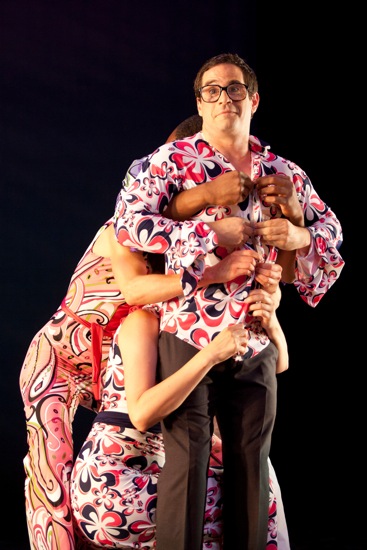
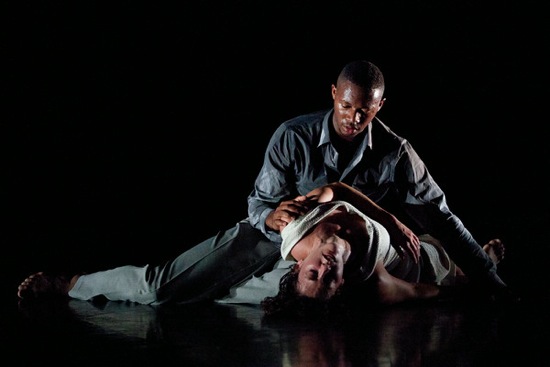
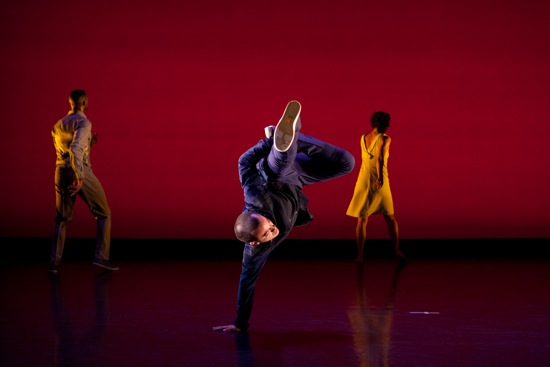
This idea is so amazing. It will be more entertaining to watch. Are there hip hop dance moves in the show? I can’t wait to see dancing it with a twist.
The choreographer Doug Elkins was involved with hip-hop early on. There are references to it in his take on Shakespeare’s Othello.